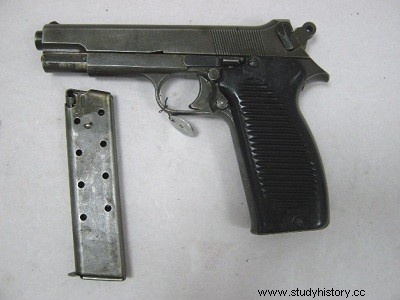
The MAC 50
The MAC model 1950 is a semi-automatic pistol developed from 1946 as part of the program of October 30, 1946 relating to the replacement of the too many models of handguns in the French armies with a single model.
Presentation
Of the two prototypes presented to the Armament Technical Section by the MAS, the most successful will be little modified and will finally meet the criteria of reliability, precision, maneuverability, stopping power and ease of maintenance by a simple dismantling that the report final of May 11, 1950 of the test commission will formalize. On August 16, 1950, the ministerial note number 11579 will officially baptize the weapon "automatic pistol of 9 MM model 1950" while the Direction of the Materials will entrust the manufacture of it to the National Manufacture of Châtellerault, the production capacity of the MAS being at that time completely absorbed in the manufacture of the new MAS 49 rifle.
Initially produced by the Manufacture d'armes de Châtellerault (MAC), then by the Manufacture d'armes de Saint-Étienne (MAS), its frame bears the markings MAC or MAS (on the left) and model 1950 caliber 9m/ m (right) making it familiarly called MAC 50 or MAS 50 by the French military and police.
The Manufacture d'armes de Châtellerault will manufacture 221,900 copies from March 1953 to June 1963 before production is taken over by the Manufacture d'armes de Saint-Étienne which will manufacture 120,000 from November 1963 to April 1978. Its design stems from its predecessor, the MAS 35, from which it borrows its removable plate, but adopting the 9 mm Parabellum caliber, or 9 Lüger, the most widely used for pistols of its generation.
This weapon is still in service with the French armed forces, where it is commonly called "PA" for "automatic pistol." »
Principle of operation:short recoil of the barrel by direct action of the gases allowing the rearward movement of the breech ejecting the empty case of the shot, the return to the front taking place thanks to the decompression of the recuperating spring, chambering again a full shot taken from the magazine contained in the handle. The weapon is equipped with a breech stopper keeping it open in the rear position on the last shot. An active safety by a lever located on the left side prevents the hammer from reaching the firing pin once raised, while a magazine safety dear to French engineers prevents any percussion if a magazine is not engaged in the pistol grip.
From 1953, the MAC 50 replaced the model 92 revolver, the MAS 35, PA 35A and other Colt 1911 in the Army and the gendarmerie, and the P38 in the CRS. It is staffed in the penitentiary and certain national police services (DST, PJ, RG and PAF). In 2000, fifty years after its first commissioning, the Army PA began its retirement and is being replaced by the Beretta 92 (MAS G1) which was provided to the National Gendarmerie , which now uses SIG PRO SP2022.
User countries
France
Algeria
Congo
Ivory Coast
Gabon
Lebanon
Madagascar used by the Gendarmerie and the Penitentiary Administration as a secondary weapon (donations offered to the Malagasy government as part of cooperation with France)
Morocco
Mauritania
Senegal
Chad (ANT)
Togo
Tunisia
Vietnam (captured weapons and local copies)
Country France
Type Automatic pistol
Ammunition 9mm Parabellum
Manufacturer Manufactures d'armes de Châtellerault (MAC) and Saint-Étienne (MAS)
Period of use 1950
Service life 1953-2010s
Production ± 340,000 copies from 1953 to 1978.
Weights and dimensions
Mass (unloaded) 900 g
Mass (loaded) 1100 g
Length(s) 195 mm
Barrel length 111 mm.
Number of stripes :4 stripes on the left with a pitch of 270 mm.
Technical features
Architecture steel frame.
Mode of action Single action lock and safety by blocking the firing pin.
Scope 100 m
Maximum range 1000 m (lost bullet)
Practical range 50 m
Rate of fire 18 rounds per minute
Muzzle velocity 315 m/s
Capacity 9 rounds (+ 1 in the chamber)
Viewfinder Fixed riser and front sight
Variants Luxury model and Cambodian copies
Category Weapon of war
